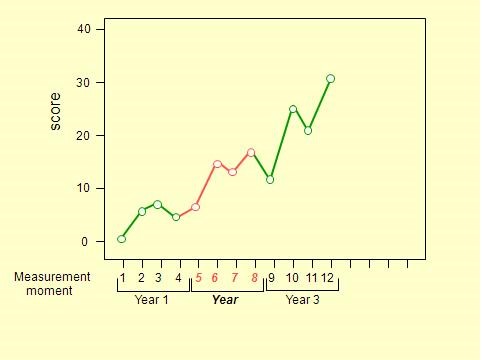Measurement moment
A measurement moment simply is the moment of taking a progress test. Two types of measurement moments are distinguished: chronological and nominal measurement moments. The student’s chronological series of scores presents the tests a student made successively. The nominal measurement moment indicates the phase of the curriculum reached by the student at the time of a PGT. For a second year student participating in the September PGT, the actual measurement moment is 5. ProF provides feedback for the Bachelor and Master phase, i.e. measurement moments 1 through 24.
The nominal measurement moment determines the student’s test result. Therefore, the series of scores at the nominal measurement moment (measurement moments for short) are the important scores in the presentation of feedback. In that representation, longitudinal feedback relates to the total score and the scores per subdomain. Additionally, the student’s chronological series of scores is offered to present a complete test overview. Momentaneous feedback is available for each of the tests included in the overview.
The following example illustrates the difference between the two types of measurement moments:
A student starts her medical studies in September 2005 and takes four PGTs in the first year. She also takes four PGTs in her second year, but she has to redo the second year. This means that during what is chronologically her third year in medical school, she follows the programme of the second year. She then passes the second year and takes the next four PGTs as a third year student. Chronologically this student has taken PGTs at the following measurement moments: (1,2,3,4, 5,6,7,8, 9,10,11,12, 13,14,15,16). However, within the context of the curriculum, the PGTs she has taken represent the following measurement moments: (1,2,3,4, 5,6,7,8, 5,6,7,8 9,10,11,12 ). She has taken the tests at measurement moments 5, 6, 7 and 8 twice. In such cases the results of the first series are disregarded and only the results of the second series count. This results in the following series of relevant measurement moments: (1,2,3,4, 5,6,7,8, 9,10,11,12 ).
Go back to the page ‘Basic concepts’


